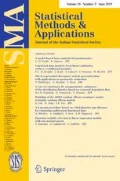Abstract.
Over the last few years many studies have been carried out in Italy to identify reliable small area labour force indicators. Considering the rotated sample design of the Italian Labour Force Survey, the aim of this work is to derive a small area estimator which “borrows strength” from individual temporal correlation, as well as from related areas. Two small area estimators are derived as extensions of an estimation strategies proposed by Fuller (1990) for partial overlap samples. A simulation study is carried out to evaluate the gain in efficiency provided by our solutions. Results obtained for different levels of autocorrelation between repeated measurements on the same outcome and different population settings show that these estimators are always more reliable than the traditional composite one, and in some circumstances they are extremely advantageous.
Similar content being viewed by others
Author information
Authors and Affiliations
Corresponding author
Additional information
The present paper is financially supported by Murst-Cofin (2001) “L’utilizzo di informazioni di tipo amministrativo nella stima per piccole aree e per sottoinsiemi della popolazione” (National Coordinator Prof. Carlo Filippucci).
Rights and permissions
About this article
Cite this article
Ferrante, M.R., Pacei, S. Small area estimation for longitudinal surveys. Statistical Methods & Applications 13, 327–340 (2004). https://doi.org/10.1007/s10260-004-0082-6
Issue Date:
DOI: https://doi.org/10.1007/s10260-004-0082-6




